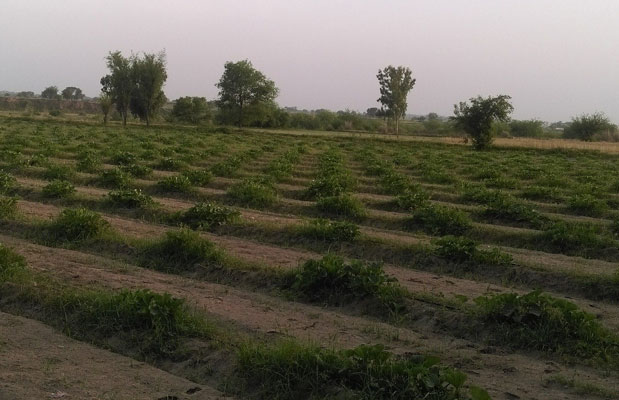By Aneel Piryani and Naveed Mustafa Rana
 Mr Jamal showing us a double-barrel well.
Mr Jamal showing us a double-barrel well.
Photo credit: Aneel Piryani/ICIMOD
We made a field visit to Khaba Barralla (a HI-AWARE study site) in Rawalpindi. This area falls under the Soan Watershed area in the Pothahar region of Pakistan. We visited Mr Jamal’s farm, which comprises 85 acres of cultivated land on the floodplains of the Tarab River. Initially an On Farm Water Management Project (OFWM) of the Government of Punjab, this land has been turned into cultivable land with the installation of a high-efficiency irrigation system. On this farm, Mr Jamal is trying to grow various crops and fruits.
According to Mr Jamal, the major problems in this area are water scarcity, changes in temperature and rainfall patterns and energy shortage. He said that innovative water management technologies would be effective in ensuring efficient use of water. He is trying drip irrigation for cultivating different vegetables on 5 acres of his land. This was implemented with the support of the OFWM’s high irrigation efficient system project, with 40 percent of the contribution coming from the farmer and 60 percent from the Government of Punjab. Because this region suffers from a lack of electricity, the present drip-irrigation system has not been successful. The system would have been more cost effective and would also help solve some of the problems to do with the energy crisis if it were coupled with a solar-energy system. The cost of the drip system is high, which farmers of small and mid-sized landholdings cannot afford. And if the big farmers opt for this drip-irrigation system, then their survival would become an issue, owing to the energy crisis and high operational costs. According to Mr Jamal, farmers would need to grow high-value cash crops with a drip system for early recovery of costs and to maximise profits, ensuring their survival.
The farmers’ land is situated on the western side of the Tarab riverbank, but the river has nearly dried out. The water scarcity is a real problem for the local farmers. As an adaptation measure, Mr Jamal has dug a double-barrel well, to overcome the shortage of water. He is using the water from this well to cultivate vegetables and traditional crops on his 85 acres of land. The water shortage is exacerbated by the changing patterns of rainfall in the area: earlier the rainfall used to occur in October, and that would provide moisture to the soil, allowing for the sowing of wheat crops. But rainfall has now become highly uncertain and shifted away from October, which badly affects wheat crops in their early stages. Furthermore, rainfall that used to occur in December and January – so important for the crops – has shifted from these months to the end of March and April. At that time, the farmers’ wheat crops become ready for harvesting, but due to the shift in rainfall, they have incurred damages.
 Different vegetables being cultivated on Mr Jamal’s farm.
Different vegetables being cultivated on Mr Jamal’s farm.
Photo credit: Aneel Piryani/ICIMOD
There is also the new phenomenon of temperature increase in the month of April, which disturbs the wheat crops at their maturity stage. For example, the size of the grain stays smaller than the normal grain size. This leads to big losses in income for the farmers because this difference in size affects the quality of the wheat. Mr Jamal thinks these changes are due to the changes in the climate. He is of the opinion that this cycle of change repeats every 10 years. The changes in climate and the problem of water scarcity have forced him to shift from rearing livestock to growing high-value crops that do not require a lot of water such as vegetables and fruits. A pertinent study would be to know how much water was required for livestock and how much water is required for the high-value crops that he is growing now.
